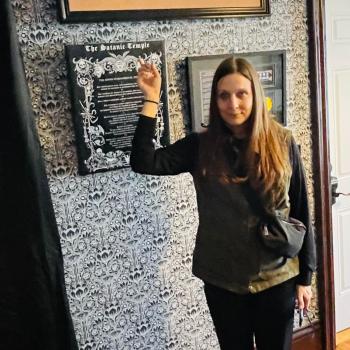Hilkiah (High Priest of Jerusalem, ca. 660-600 BCE) knew what had happened to the inhabitants of the northern kingdom. When they were conquered and deported by the Assyrians in 722 BCE, they had intermarried with and merged into the local population, because they did not have a concept of themselves as being significantly different from other people. Hilkiah knew that such a fate loomed over the people of Judah, the southern kingdom formed when the united kingdom had split after the death of Solomon. Given the current political situation, with aggressive empires rising and falling in Mesopotamia, conquest and deportation was more likely with every passing year. But he did not want the Judeans to also disappear as a distinct people. They did have an identity different from that of the northerners, because they had owned and operated the temple in Jerusalem for almost 400 years. How could they be protected from such a fate?—so he must have wondered.
The temple was the center of what made Judeans different, the temple dedicated to the worship of Yahweh, the traditional god of the Israelites, that is, the people who shared a belief in their descent from the twelve sons of Jacob, who had taken the name Israel after wrestling with an angel. But the temple was in fact not devoted solely to the worship of Yahweh. It housed statues of the goddesses who were believed to be Yahweh’s wives, for just one example, and the practices of the people outside of Jerusalem were concerned even less with Yahweh. Hilkiah’s son Jeremiah, the archetype of the fire and brimstone preacher, had begun advocating some years earlier that the Judeans should worship only Yahweh, their special god, and not the gods of other peoples. Could such an obligation be the beginning point for devising a way to protect them? That, or something like that, must also have been what Hilkiah was thinking about.
Hilkiah knew the legends about Abraham, Isaac, and Jacob, about Moses, Aaron, and Joshua, about the early leaders of the Israelites, before David and then Solomon employed a college of scribes, like those employed by most temples in Mesopotamia and Egypt, that began keeping records and writing the beginnings of histories. But those legends were all oral traditions, told and retold and evolving as they were passed down from generation to generation, and with many local variations and different customs associated with them. Hilkiah surely must have believed that the legends were basically true as history, but there was no authoritative compilation of them, because they had never been written down. The oral traditions about what divine commandments Moses had proclaimed were interpreted by prophets, each in his or her own way, as authorized by their own experience with the divine. Hilkiah began to think to think about whether, and then how, to write them down.
I first ran into the concept that Hilkiah had begun the writing of the Torah in Joseph Campbell’s Occidental Mythology, in which Campbell points out that the story told in II Kings 22 is so utterly different from the story of Moses as laid out in the Torah that it must in fact be the ordinary history of how Judaism came to be the official state religion of the kingdom of Judah. One consequence of believing that Judaism was founded by Moses in about 1300 BCE is that it blinds one to the importance of Hilkiah as its true founder, as one of the great religious architects of history. The story of Moses is one of the most profound, beautiful, and historically important stories ever written, but to think, in the 21st century, that is merely ordinary history is as childish as thinking that one knows the exact coordinates of the Tooth Fairy’s palace. All religions have both a foundation myth and an actual history. The Jewish scriptures are unique in that they include both.
The next major factor that focused my attention on Hilkiah was my brief friendship with the late Rabbi Sherwin Wine, the founder of Humanistic Judaism as a fifth branch, which began when I was working as an editor for Jeremy Tarcher. One day in 1991, Sherwin’s literary agent, Susan Levine, walked into my office and offered me the manuscript of Sherwin’s book How to Be Sane in a Crazy World. My reaction, as she handed it to me, was “Really!?!”—because I had heard of him. Jeremy never did publish the book, because he wanted to put a metaphysical spin on it, and Sherwin, as a major macher in the Humanist movement, wasn’t having any of that, but as a result I was privileged to have many hours of conversation with him. Thus I learned about his belief that Judaism had begun as focused, not on monotheism, but on the identity of the Jewish people, the identity, I now perceive, that was conjured into existence by Hilkiah’s inspired vision of it.
How, you may ask, could Judaism not be focused on monotheism? As Sherwin emphasized to me, Judaism began with a henotheistic theology. In the core of Deuteronomy—that is, the part that Hilkiah wrote as “The Book of the Law of Moses”—Yahweh is conceived of as the Israelites’ special god, and as the best of all the gods, but not as the only god. (The latter concept first appears only about 75 years later.) Hence in Deuteronomy, the first of the Ten Commandments says, “Do not put other gods before me”; that is, don’t give them precedence; but their existence is assumed.
The story in II Kings 22 says that in 621 BCE, the young king of Judah, Josiah, has sent his secretary to pay the workmen who are repairing the temple. The secretary returns with the news that Hilkiah has found the “Book of the Law of Moses.” (This passage is often interpreted as meaning that the workmen had found it hidden in a secret room in the temple, but that is not what the text says.) Josiah has never heard of the Law of Moses as being a written document, but only as oral tradition. When the book is read to him, he is horrified to learn there are many commandments that the Judeans have not been fulfilling. He sends the scroll to the local prophetess, Hulda, to find out if she thinks it is genuinely the Law of Moses. She sends back word that it is (which was generous of her, since having the Law written down abolished her profession; one must infer that she was in on the plan). Josiah then calls a town meeting and has the scroll read in public. The people acclaim it as the new constitution for the kingdom; that is, this was the first covenant. Josiah then assiduously begins extirpating the details of all non-Yahwistic practices from the temple, Jerusalem, Judea, and even parts of the northern lands, now known as Samaria.
The Book of the Law of Moses begins in Deuteronomy 4, where Moses begins speaking in first person, saying “Hear, O Israel”—but what we are hearing is the voice of Hilkiah, speaking through the mask of Moses. The central scene in “The Book of the Law” is where Moses descends from Mt. Sinai with the laws inscribed in stone. This is not part of a legend. This is Hilkiah’s own literary composition. Hilkiah needs laws that are not vague verbal formulations, but that are set in stone (whence we get that cliché) to be the foundation of the new religion he is creating. Moses’ seeing the Israelites worshiping a golden calf (that’s actually in Exodus, but the writing might go back to Hilkiah) is exactly the situation that Hilkiah was facing.
Traditionally, there are 616 mitzvot counted in the Torah, most of them in the Book of the Law within Deuteronomy. Many of them are the ordinary kinds of laws that any government needs; and it seems plausible that Hilkiah knew about previous law codes, like that of Hammurabi. But many of these mitzvot seem strange or even pointless, until one focuses on Hilkiah’s purpose in writing them: to forge a unique identity for the people of Judea. To this end, he created rules that would set them apart from the surrounding people. For example, the most obvious example, the forbidding of pig meat. Speculations about whether that was done for health reasons are wrongheaded. Pigs were one of the animals most commonly used for sacrifices in the Mediterranean world. They were easy to raise and cheap to feed, and figured prominently in Greek religious practices. (I have not found evidence on whether they had been forbidden before Hilkiah’s time.) Similarly, other rules forbid practices typical of other religions and enshrined practices that could be carried out only in the Temple, particularly the sacrificing of the lamb for Passover. II Kings 23:22 comments that such a Passover as was carried out according to the new rules was unlike any Passover since the time of the Judges, about 600 years earlier, that is, in practice, there had never before been such a Passover. .
Another example is the mitzvah that says, “Do not seethe a kid in its mother’s milk.” This rule proliferated into the prime kashrut rule of not mixing milsch and fleisch, in order to avoid any possibility of that happening. What was the point of that? Meat boiled in milk was considered a delicacy in those cultures. In addition, in the documents known as the “Orphic gold plates” (which seem to be funerary epitaphs for persons killed by lightning) occurs the line, “A kid, I have fallen into milk,” that is, into good fortune. Hence this rule meant that Judeans could not eat with others, clearly setting them apart as a special people, as Hilkiah intended to do.
When the Babylonians conquered Judea and deported the Jewish people—for that is what they had now become—to Babylon in 586 BCE, a full generation, almost two, had grown up in the new culture. In Babylon, under pressure to convert to the state religion of worshipping the seven “visible gods,” they were able to refuse and to keep their identity, as Hilkiah had hoped. The story enshrined in Exodus, of their becoming a unique people while in captivity, did happen—but in Babylon, not Egypt.
In Babylon, the people wondered why Yahweh had allowed Jerusalem to be destroyed when they had been fulfilling the commandments, but then an idea occurred to Deutero-Isaiah (the middle of the three authors of the book of Isaiah) about 550 BCE, that Yahweh was not merely the best god, but was the only god; so the people were being punished for that misunderstanding. Note that this Isaiah was contemporary with the pre-Socratic philosophers who reasoned that there must be a single ultimate reality underlying our phenomenal world, but one that is able to be both One and Many at the same time.
When Cyrus of Persia captured Babylon in 536 BCE and told the Judeans they could go home, only about a third did, taking Deutero-Isaiah’s concept with them. For the rest, Babylon had been home for 50 years; it remained the second oldest Jewish community down to the 20th century, and there the Babli, the larger compilation of the Talmud, was composed.
In Jerusalem, the Judeans began attempting to rebuild the temple, and began rewriting their history into one of Yahweh’s trying to get them to grasp his true nature, a project that took almost 150 years to complete. Genesis was written very late in the process, because it is the overture, focusing a mythical history down to its literary purpose: getting Joseph into Egypt to set the scene for the historical novel about Moses that serves as the skeleton on which to hang the laws.
. The work on the temple was stalled by political problems until the Persian emperor dispatched Ezra as the de facto governor shortly after 400 BCE. Ezra was able to complete the rebuilding, institute some new laws, and complete the writing, editing, and publishing of the Torah; that is, it was codified, canonized, and locked against further editing. As one of his new laws, Ezra created the definition that membership in the Jewish people was inherited through the maternal line. He spent months going through the records and, with the authority of the Persian Empire backing him, forcing Jewish men to divorce their Gentile wives—and why had so many men done that? Because, before Ezra, there had been no law against it. (Note that the books of Ezra and Nehemiah are pure history; they even cite official documents.)
When the Torah was complete, Ezra and his staff called a public meeting and read through it aloud, in approximately the year 385 BCE. It seems clear that Ezra staged this meeting to match the description in Exodus of Moses reading the law to the assembled Israelites at the foot of Mt. Sinai. When the reading was complete, the people renewed the covenant that had been made under Josiah, but this time to the completed Torah, as the constitution of Judea. As the Torah is by definition what is read in the synagogue, the assembly that day was the first synagogue meeting; and as the Rabbi is defined as the expert on the Law, which was now complete, Ezra was the first Rabbi, and all Rabbis since, including Sherwin Wine, have traced their rabbinical authority back to him.
In our next episode, I will explain why the accomplishments of Hilkiah provide an almost exact historical parallel to those of Gerald Gardner.
.














